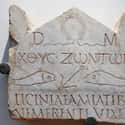-
(#1) The Few Descriptions Of Jesus In The Bible Contradict Each Other
In general, the New Testament gives little description of the appearance of Jesus or anyone else for that matter. The few descriptors that do exist are hardly foolproof evidence, as they describe Jesus in some crazy, not-of-this-world terms.
In John's vision of Jesus in the Book of Revelation: "The hair on his head was white like wool, as white as snow, and his eyes were like blazing fire... His feet were like burnished bronze... His face was like the sun shining at its brightest" (1:14-16). Obviously, this depiction speaks to Jesus less as a human being and more as God, and it doesn't really state his racial make-up other than as a bronzed-footed, white-haired shiny man with fire eyes.
Old Testament descriptions speak of the coming Messiah (which Christians believe to be Jesus) and describe him as "fairer than the children of men" (Psalms 45:2). And a verse in Lamentations believed to refer to Jesus states, "Her Nazarites were purer than snow, they were whiter than milk, they were more swarthy in body than rubies, their polishing was of sapphire: Their visage is blacker than coal" (4:7-8). So, while purer than snow, the Nazarites' visages (AKA their faces) were black; does this give you a clearer picture?
This imagery is most likely meant in a figurative sense, but it gives cause for misinterpretation of the literal image of Jesus. And these descriptions even change depending on the version of the Bible you read.
-
(#2) Whiteness Is Associated With Purity, And Jesus Was Pure So...
The color white is frequently symbolic of purity in the Bible. Jesus is frequently referred to as "the lamb of god," and the holy spirit is often depicted as a white dove. This long-lasting association between the color white and goodness/purity could be part of the reason Jesus was depicted as white.
Or, alternatively, it could explain a larger misunderstanding of interpreting figurative whiteness from the Bible as a literal light skin tone. Anyone can have a conscience so pure that it's white like snow, and it doesn't necessarily mean their racial appearance is white. The connection between the color white and purity has long been misused to justify racism and slavery.
-
(#3) Early On, Christians Were Too Persecuted To Create Jesus Representations
After Jesus' death, being his known homie wasn't exactly cool. Christians were persecuted by the Roman Empire for several centuries after his death, and followers therefore relied on symbols to represent their religious beliefs and secretly connect with one another. These symbols included the ichthyos, (the Jesus fish still prevalent today), and the Chi-Ro, a monogram of the letters chi (X) and ro (P), the first two letters in the Greek word "Christos," meaning Christ.
Unfortunately for historians, this means that there are virtually zero depictions of Jesus from the time when people actually might have accurately remembered what he looked like. Womp womp.
-
(#4) The Romans Didn't Exactly Want To Glorify An Oppressed Minority
In the sixth century, Byzantine artists began portraying a white-skinned, middle-hair-parted, bearded Jesus. Why did they do this when the earliest depictions of Jesus show him with a darker complexion? According to Biblical scholar Christena Cleveland, in reality, Jesus would have been an ethnic minority even during his own lifetime. And, even then, "Jews were marginalized by Romans, Greeks, and other non-Jewish groups in many imperial cities."
And Jesus wasn't a silent minority either. In the Bible, he's quite the rabble rouser, literally organizing grassroots efforts to aid the poor and needy against the rich and powerful. Probably not the image of God the Roman Empire really wanted to shout from the rooftops. Less radical and less brown made for a better deity in the Roman imagination and directly contributed to the White Jesus so prevalent today.
-
(#5) Roman Artistic Depictions Became Mainstream
By the 5th century, with Roman Emperor Constantine's conversion to Christianity, Jesus was all the rage, and artistic depictions began to flourish in the Roman Empire. The classic representation of Jesus today - as a white man with longish brown hair, a beard, and a halo - became prolific under Constantine. As the artwork was mostly being created in Rome, it's likely that they painted their Messiah as appearing similar to themselves, with European features and lighter skin, to deepen their own connection to him.
-
(#6) Documents Of Questionable Origin Began Describing His Appearance In The Middle Ages
As Christianity became acceptable, and then even popular, people realized they didn't have any true physical renderings of their savior, Jesus Christ. So they did what people do best and started making stuff up.
A forged letter from one Publius Lentulus (circa 14-37 CE) to the Roman senate claims to give a physical description of Jesus, saying he is tall, wavy-haired, rosey-cheeked, and blue-eyed. The only problem is that there's pretty much no way this letter was written at the time it claimed to be, as there was no such Lentulus during this time period, and it includes many phrases and references that place its creation sometime around the 13th century.
Several other supposed ancient descriptions of Jesus arose during this time, but, like the Lentulus letter, they have been dated to the Middle Ages, when artistic depictions of Jesus would have already become commonplace and influential.
-
(#7) People Claimed To Have Visions Of Jesus That Made Him White
In addition to the documents claiming to be first-hand accounts of what Jesus looked like, many famous 'miracle images' and visions of Christ popped up around the Middle Ages. The Image of Edessa, for example, supposedly bears the image of Jesus from a towel Christ wiped his face on during his lifetime. But people - being like they are - are phonies, and this towel image, as well as many other famous artifacts claiming to have captured the face of Jesus, are widely dated by historians to the Middle Ages rather than Jesus' lifetime.
-
(#8) Romans Associated Non-Whites With Non-Believers
By the Middle Ages, the Roman Empire had been replaced with papal authority, and the time period was marked by Crusades (AKA Holy Wars) against Muslim forces in and around the the Holy Land (AKA Jerusalem). The continual religious fighting during this time was between European Christians and Middle Eastern Muslims. Therefore, from the perspective of the Christian forces, the non-believers and the enemy were non-white. Despite the fact that Jesus probably looked more like these people than Europeans, his image as a white man was crucial to the Crusades and their mission. They certainly wouldn't have painted him to look like the enemy.
-
(#9) Artists Had Numerous Incentives To Portray Jesus As White
While Popes weren't the ones painting the pictures, artists during this time could've faced some dark consequences for going against the Church and its accepted depiction of Jesus. For most starving artists, compromising in their rendering of Christ certainly beat out getting burned for heresy.
In addition, artists would want to actually sell their artwork, which would have been difficult if they strayed from the popular and mainstream image of White Jesus. Having one agreed-upon image of the savior helped to unify the religion and worked as proof against the nay-sayers.
-
(#10) White Jesus Was A Necessary Tool For Slavery
Slavery was built on the premise that only certain racial groups (the white one) possessed higher-order faculties like morality. Under this way of thinking, Black Africans had souls somewhere beneath their "heathen" behaviors and exteriors, and it became Europeans' "Christian duty" to convert them. White Jesus was an essential tool in this fight for the souls of the slaves. As the scholar Francesca Ramsey points out: "white supremacy" was "used in Christianity to colonize and control before and during slavery," and Jesus represented whiteness, purity, and European superiority; a more Israeli-looking Jesus simply wouldn't have worked in the same way.
Biblical scholar Christena Cleveland adds: "By negating his true identity as a dark-skinned, oppressed minority, slaveholders were better able to justify the master-slave hierarchy and forget Jesus’ ministry to set the oppressed free (Luke 4:18)."
-
(#11) The Nazis Claimed Jesus Was Aryan
The image of white Jesus was initially popularized by Europeans in the Middle Ages to support their own political and racial agenda against Arabs. And since then, it has similarly been misused for racial bias.
In the 19th century, folks tried to make Jesus even whiter. The idea that Jesus was Aryan, or specifically Nordic, arose in accordance with anti-semitism. Scholars attempted to separate Jesus from his Jewish roots, which culminated in the Nazi ideology of "Positive Christianity." The racially charged argument posited that there was a religious Judaism separate from an ethnic or racial Judaism. Theories also claimed Galilee (where Jesus was from) was a non-Jewish region speaking an Indo-European language, which has been widely debunked.
-
(#12) Mainstream Media Continues To Portray Jesus As White
The US has adhered to the not-so-grand tradition of white-washing Jesus in film and television by exclusively casting white actors, like Willem Dafoe and Chritian Bale, as Christ. In the 20-something films made about Jesus throughout the 20th century, white actors have almost exclusively been cast as Christ. It wasn't until the 2015 National Geographic mini-series Killing Jesus, that a Middle Eastern actor (Lebanese actor Haaz Sleiman) was cast as Jesus in a major English-language film.
-
(#13) New Attempts To Describe Jesus' Race Remain Vague
In 2001, BBC claimed to unveil the "real" face of Jesus after analyzing excavated skulls of 1st century CE Jews with computer imaging. Biblical evidence suggests that Jesus didn't look especially different from others in the region. For instance, in the New Testament the infamous kiss of Judas is used to betray Jesus by identifying him to his captors. Were his looks notably distinct, this identification would not have been necessary.
The new likeness of Jesus BBC created was unsurprisingly darker-skinned than the mainstream white Jesus depictions. But still, his image was appraised simply as "olive-skinned" and "swarthy," vague terms that leave his race ambiguous and allow those devoutly on Team White Jesus to still claim he was just tan and not Arab.
-
(#14) Historians Can't Prove His Race Beyond A Shadow Of A Doubt
While historians can nearly definitively say that Jesus was not white, the answer of what exactly he looked like will always be an educated guess. Examining without bias a man, who has been so revered, discussed, and depicted as God is probably impossible at this point. Any evidence existing from his lifetime is tainted, in a sense, by theological bias.
When there is room for doubt, people will unfortunately continue to adhere to the belief that Jesus was a white man. Why? As written by Jamelle Bouie for The Daily Beast, "[at] best, the assertion of Jesus’s whiteness reflects ignorance. At worst, it’s a sign of racial prejudice."
-
(#15) White Jesus Is More Oppressive Than Black Or Korean Jesus
So, at this point, you might be saying to yourself: don't other racial and ethnic groups of Christians create representations of Jesus that look like themselves? Aren't there Black and Korean versions of Jesus? Why all the focus and criticism of White Jesus? If you're asking yourself these kinds of questions, you're right - to a point. Undoubtedly, representations of Jesus get created in the likenesses of the groups who worship him; people have a way of liking to see themselves in their deity. The big difference is that Black and Korean Jesus aren't as oppressive as White Jesus; they haven't been used as a tool of suppression throughout history.
According to the scholar Francesca Ramsey, the "pure" whiteness of Jesus plays into the longstanding "narrative of dark skin people being bad, thus needing to be tamed or killed in order to confirm to the good, or white, standard." Added to that is the fact that, during slavery, Christianity was used as a tool of oppression and a justification for wrongdoing. Black and Korean Jesus simply don't carry that historical baggage, and they definitely aren't as widespread.
New Random Displays Display All By Ranking
About This Tool
In many Western artworks, Jesus is depicted as having white skin and light-colored hair. Is this what Jesus really looks like? If not, why has he always described this way? What needs to be clear is that there is no description of Jesus' appearance in the Bible. According to the Bible, Jesus was a Jew, that is, a Hebrew or an Israeli. Therefore, he is likely to have light brown to medium brown skin.
If you look at the depictions of Jesus by artists from all over the world, you will find that Europeans portray Jesus as a European, and Africans portray Jesus as an African. The random tool explained 15 reasons why Jesus is depicted as being white in most artworks.
Our data comes from Ranker, If you want to participate in the ranking of items displayed on this page, please click here.
























